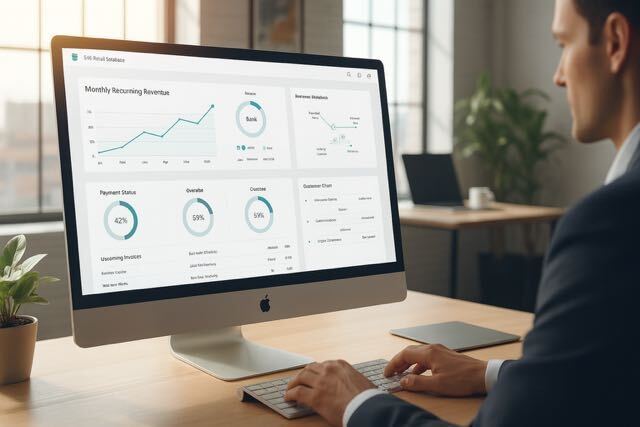What Are the Key MSP Metrics for Profitable and Sustainable Growth?

The managed services market is booming, with 67% of companies outsourcing at least some part of their IT infrastructure to Managed Service Providers. Revenue's coming in, clients seem happy, and your team is busy. But a nagging question lingers – are you truly on the path to sustainable growth? Are you maximizing profitability, optimizing efficiency, and exceeding client expectations?
Relying on gut feeling just won't cut it for MSPs. This blog throws open the doors to your data war room, equipping you with the essential MSP metrics that every managed service provider needs to track for success. These aren't vanity metrics – these are the hard data points that illuminate the true picture of your business growth. This blog is your guide to building sustainable growth, packed with the essential MSP metrics for success. Let’s find out more!
Financial Fitness: The Cornerstone of Sustainability
In the relentless pursuit of growth, many MSPs get caught up in irrelevant metrics. But true financial fitness hinges on a core set of metrics that illuminate the path toward sustainable growth. This section dissects the key financial metrics you need to track religiously, along with actionable hacks and, where applicable, formulas to maximize their impact on your MSP's success.
1. Monthly Recurring Revenue (MRR):
Consider MRR the lifeblood of your MSP. It represents the predictable, recurring revenue generated from monthly service contracts. A healthy MRR signifies a stable financial foundation and fuels sustainable growth. Here's a simple formula to calculate it:
MRR = Total Monthly Recurring Revenue / Number of Months
Alternative Method (for Averaging):
If your monthly recurring revenue fluctuates slightly, you can calculate an average MRR over a specific period (e.g., past 3 months) using this formula:
Average MRR = Sum of Monthly Recurring Revenue (over a period) / Number
How to Maximize MRR:
- Client Retention is King: Focus on keeping existing clients happy. Implement proactive account management practices, offer exceptional service, and address client concerns promptly. A happy client is a loyal client, and loyal clients translate to a steady stream of MRR.
- Upsell & Cross-Sell Strategically: Identify opportunities to upsell existing clients on higher-tier service packages or introduce them to complementary services that address their evolving needs. Zomentum's proposal software empowers you to create customized proposals that showcase the value proposition of these additional services, streamlining the upsell/cross-sell process.
- Target High-Value Clients: Not all clients are created equal. Refine your ideal customer profile to target clients that require comprehensive managed service packages, leading to higher monthly recurring revenue per client.
2. Customer Lifetime Value (CLTV):
Customer Lifetime Value (CLTV) looks beyond immediate revenue, measuring the total revenue a client generates over their entire relationship with your MSP. A high CLTV indicates strong client relationships and a sustainable revenue stream.
The formula for Customer Lifetime Value (CLTV):
CLTV = Average Revenue per Account (ARPA) x Average Customer Lifespan
How to Boost CLTV:
- Nurture Client Relationships: Treat your clients like valued partners. Regularly communicate successes, address concerns proactively, and foster trust. Strong client relationships encourage long-term commitment and repeat business, boosting CLTV.
- Deliver Exceptional Service: Surpass expectations with exceptional service. Respond promptly to client inquiries, proactively address potential issues, and prioritize client satisfaction. Happy clients are more likely to expand their service portfolio with your MSP, increasing CLTV.
- Expand Service Offerings: Don't be a one-trick pony. Continually evaluate your service portfolio and introduce new offerings that address emerging client needs. Zomentum can help streamline the creation of proposals for these new services, allowing you to capitalize on these growth opportunities.
3. Profitability:
Profitability, not just revenue, is the true measure of success. Track your profit margins for individual clients and services to identify areas for improvement.
- How to Enhance Profitability:
- Track Profit Margins: Monitor the profitability of individual clients and service offerings. This can be done using the following formula:
Profit Margin = (Revenue - Cost of Goods Sold (COGS)) / Revenue x 100
Analyze services or clients with low margins. Are there opportunities to optimize service delivery processes or adjust pricing structures? Zomentum's reporting features can help you automate the generation of detailed profitability reports, providing valuable insights for informed decision-making.
- Reduce Client Acquisition Costs (CAC): Acquiring new clients is essential, but it shouldn't come at an exorbitant cost. Monitor your CAC and implement strategies to reduce it.
The formula for Client Acquisition Cost (CAC):
CAC = Total Sales & Marketing Costs / Number of New Clients Acquired
Zomentum's sales pipeline management tools can help streamline your MSP sales process, reduce wasted efforts, and ultimately lower your CAC.
- Embrace Automation: Automate repetitive tasks wherever possible. Zomentum's powerful automation features can streamline service delivery, reduce administrative overhead, and free up your team to focus on high-value activities, ultimately boosting profitability.
4. EBIDTA:
While profit is crucial, EBIDTA (Earnings Before Interest, Taxes, Depreciation, and Amortization) offers a more comprehensive view of your MSP's financial health. It reflects a company's operating profitability, taking into account core business activities. Here's the formula:
EBIDTA = Net Income + Interest + Taxes + Depreciation + Amortization
How to Leverage EBIDTA:
- Benchmarking: Compare your EBIDTA to industry benchmarks to assess your financial performance relative to your peers. A healthy EBIDTA indicates efficient operations and the
- Track Trends: Monitor your EBIDTA over time to identify trends. Is your EBIDTA increasing steadily? Are there seasonal fluctuations? Analyzing trends can help you assess the effectiveness of your financial strategies and identify areas for improvement.
- Strategic Decision-Making: Use EBIDTA as a key metric when making strategic decisions. For instance, a healthy EBIDTA can provide the financial confidence to invest in new technologies or expand service offerings, fueling future growth.
Beyond the Bottom Line: Operational Excellence for Growth
Financial metrics are the bedrock of a healthy MSP, but true sustainable growth hinges on operational excellence. This section dives into key metrics that illuminate your service delivery efficiency, and client satisfaction, and ultimately, fuel organic growth through happy, loyal clients.
5. Resource Utilization:
Your team's expertise is a goldmine. But even the most skilled technicians can become bottlenecks if overworked or underutilized. Resource utilization rate tracks how efficiently your team allocates their time.
How to Calculate Resource Utilization Rate:
There's no one-size-fits-all formula, but a common approach is:
Resource Utilization Rate = (Total Billable Hours / Total Available Hours) x 100
Explanation of Terms:
- Total Billable Hours: This represents the total number of hours your technicians spend on client work that can be invoiced.
- Total Available Hours: This is the total number of hours your technicians are available to work during a specific period (e.g., per week, per month). This typically excludes vacation time, sick leave, and scheduled training hours.
Optimizing Resource Utilization:
- Leverage Automation: Zomentum's powerful automation features can streamline repetitive tasks like patching, security updates, and report generation. This frees up valuable technician time for higher-value activities like proactive client consultations and problem-solving.
- Implement Smart Scheduling: Use Zomentum to schedule tasks efficiently, considering technician skillsets, client priorities, and workload distribution.
- Track Trends & Analyze Data: Monitor resource utilization rates over time. Identify technicians who are consistently overloaded or underutilized. Adjust workloads, redistribute tasks, or consider upskilling/cross-training technicians as needed.
6. Customer Satisfaction (CSAT):
Happy clients are your biggest advocates. Customer Satisfaction (CSAT) measures overall client happiness with your services. Regularly tracking CSAT helps you identify areas for improvement and ensure your service offerings exceed client expectations.
How to Measure CSAT:
Conduct surveys or implement feedback mechanisms after service interactions (e.g., ticket resolution, project completion). Surveys can be simple, with options like "Very Satisfied," "Satisfied," "Neutral," "Dissatisfied," and "Very Dissatisfied."
Boosting Client Satisfaction:
- Proactive Communication: Keep clients informed about service updates, potential issues, and resolution timelines.
- Prioritize Client Needs: Be responsive to client inquiries and concerns. Address issues promptly and demonstrate a genuine commitment to client success.
- Gather & Act on Feedback: Analyze CSAT data regularly. Identify recurring pain points and implement changes to address them. Communicate these improvements back to your clients.
7. Service Level Agreement (SLA) Adherence:
Trust hinges on reliability in a managed IT services business. Service Level Agreements (SLAs) define the specific service guarantees you offer clients (e.g., uptime percentages, and response times for critical issues). Consistently meeting these SLAs is paramount.
How to Track SLA Adherence:
Zomentum can help automate SLA monitoring. The software can track metrics like uptime, response times, and issue resolution times, allowing you to identify areas where adherence might be slipping.
Maintaining High SLA Adherence:
- Invest in Proactive Maintenance: Regular preventive maintenance can significantly reduce the risk of service disruptions and ensure adherence to uptime guarantees.
- Clearly Define & Communicate SLAs: Ensure your SLAs are clearly defined, measurable, and communicated transparently to clients.
- Empower Your Team: Equip your technicians with the tools and training they need to resolve client issues efficiently, minimizing downtime and exceeding response time expectations.
8. Net Promoter Score (NPS):
The Net Promoter Score (NPS) is a powerful metric of client loyalty. It measures how likely clients are to recommend your services to others (on a scale of 0-10, with Promoters scoring 9-10, Passives scoring 7-8, and Detractors scoring 0-6). A high NPS indicates strong client relationships and the potential for organic growth through referrals.
How to Calculate NPS:
NPS = % of Promoters - % of Detractors
Turning Passives and Detractors into Promoters:
- Analyze NPS Feedback: Dig deeper into NPS responses, particularly from Passives and Detractors. Identify recurring themes and areas for improvement.
- Respond to Feedback Promptly: Actively reach out to address concerns raised in NPS feedback. Demonstrating that you value client feedback goes a long way in building trust and loyalty.
Unique Metrics That MSPs Can Consider
While the core financial and operational metrics covered previously are essential, MSPs can gain a competitive edge by tracking additional, unique metrics that provide deeper insights into specific aspects of their service delivery. Here are a few key examples:
9. Technical Debt Resolution Rate:
This metric goes beyond just fixing problems; it measures how efficiently you resolve them. Track the percentage of technical issues addressed within a specific timeframe (e.g., within 24 hours, or a week).
Formula:
Technical Debt Resolution Rate = (Number of Issues Resolved Within Timeframe / Total Number of Issues) x 100
A high resolution rate indicates a proactive approach to problem-solving, minimizes downtime for clients, and fosters trust.
10. First Contact Resolution (FCR):
Not all issues require multiple interactions. FCR measures the ability of your service desk to resolve client inquiries on the initial contact. A high FCR translates to efficient troubleshooting, reduces back-and-forth communication, and improves client satisfaction.
11. Customer Effort Score (CES):
Client satisfaction is multifaceted. While CSAT focuses on overall happiness, CES measures the ease clients experience when interacting with your MSP business. This could involve resolving issues, accessing support channels, or understanding service offerings.
A low CES score indicates a need to:
- Simplify processes (e.g., online knowledge base, self-service portals)
- Improve client communication
- Streamline workflows
12. Service Delivery Efficiency:
Meeting SLAs is just the baseline. Service Delivery Efficiency goes a step further, measuring the time and resources needed to deliver specific services. By tracking efficiency, you can identify opportunities to:
- Automate tasks (Zomentum can help!)
- Streamline workflows
- Reduce the cost of service delivery
This ultimately translates to higher profitability and the ability to offer more competitive pricing.
13. Security Incident Response Time (SIRT):
In the cybersecurity arms race, speed is critical. SIRT measures the average time taken to identify, contain, and address security threats within a client's environment. A low SIRT demonstrates a proactive security posture and minimizes potential damage from cyberattacks.
14. Patch Deployment Rate:
Keeping software up-to-date with security patches is essential. This metric tracks the percentage of systems within your client base that have received the latest critical patches. A high deployment rate signifies a commitment to proactive security measures and reduces the risk of vulnerabilities. Zomentum can help automate patch deployment across your client base.
15. Upsell/Cross-Sell Ratio:
Focus on the clients you already have! This metric evaluates the effectiveness of your sales efforts for existing clients. It compares the number of upsells (upgrading existing services) and cross-sells (selling new, complementary services) to existing clients. A healthy ratio indicates successful client relationship management, increased customer lifetime value, and sustainable recurring revenue growth.
By incorporating these unique metrics alongside your core financial and operational benchmarks, you gain a comprehensive view of your MSP's performance. This empowers you to identify areas for improvement, optimize service delivery, and ultimately achieve sustainable growth.
The Bottomline
The path to sustainable growth for MSPs is paved with data-driven insights, operational excellence, and the right tools. By religiously tracking the core financial and operational metrics outlined in this blog, you gain a clear view of your business growth and identify areas for improvement.
But you don't have to do it alone. Zomentum empowers you to take actionable steps to optimize your service delivery, maximize profitability, and exceed client expectations. How?
Well, Zomentum Grow streamlines your sales process with features like quote generation, e-signing, etc. while Zomentum Payments simplifies recurring revenue collection and management. These are just a few examples – Zomentum offers a comprehensive suite of tools designed to address the specific needs of MSPs.
And believe it or not, you can experience the power of Zomentum firsthand – absolutely free! Book a live demo today and discover how Zomentum can be free forever. Transform your MSP into a sustainable growth machine!





.png)









